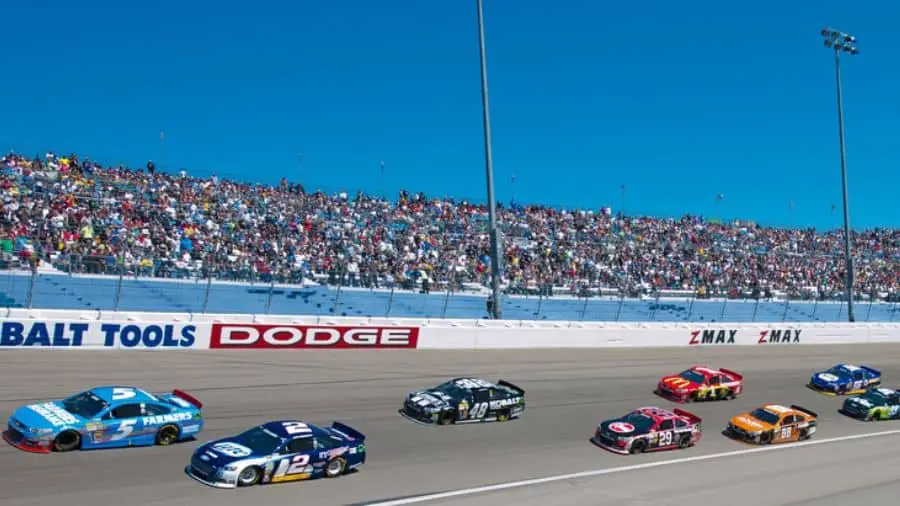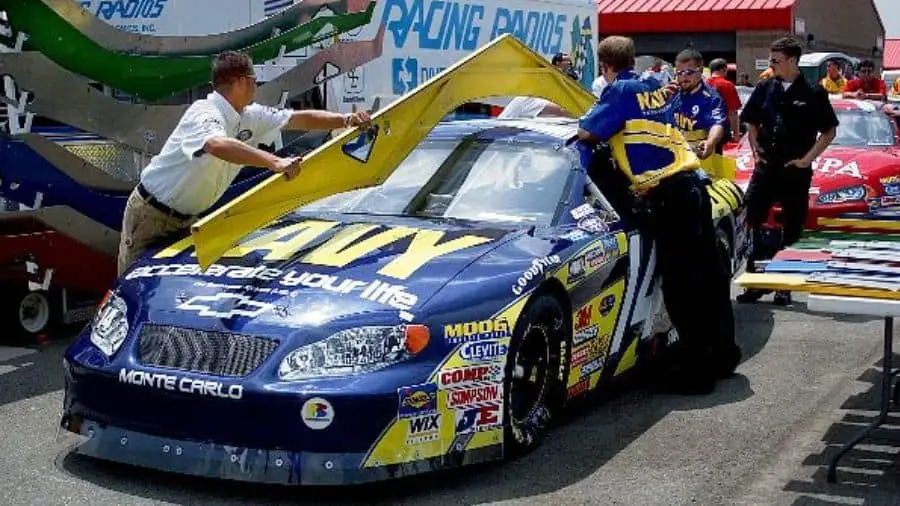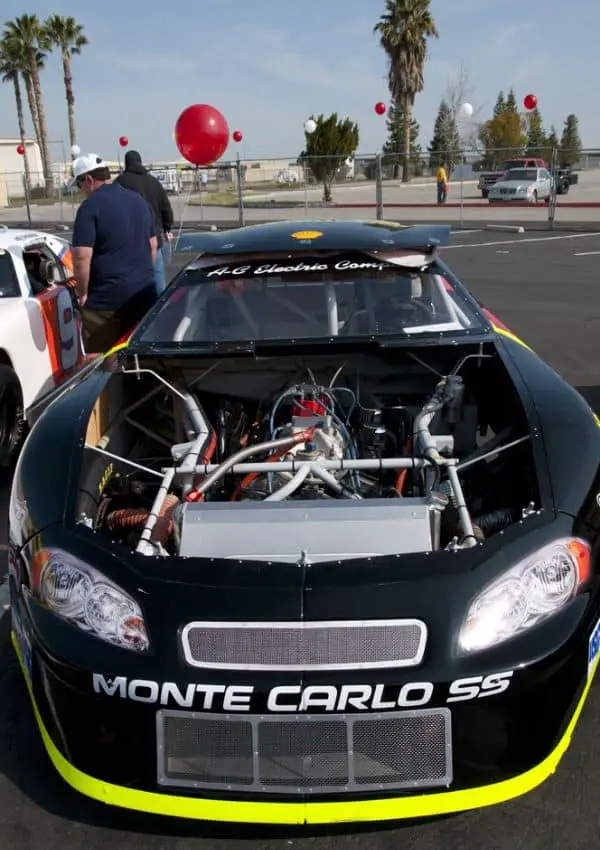
Racing past you in a long and thundering blur, you might be thinking all NASCAR cars are the same? While NASCAR rules are very strict to make for close and safe racing action, what we learned was a little surprising: we have the truth right here for you.
NASCAR cars aren’t all the same. While NASCAR’s regulations require teams and manufacturers to comply with a stringent set of specifications, what distinguishes between the different NASCAR cars are their engines and body shells. Components such as tires, suspension, fuel and fuel systems, electronics and transmission are, however, identical.
Three manufacturers compete in NASCAR’s top-tier Cup Series: Chevrolet, Ford and Toyota. The 43 racing drivers from 22 teams are all capable of winning any of the 36 races of a season, and that’s what attracts the millions of fans to this adrenaline-fueled motorsport.
Keeping the NASCAR cars as close to each other in terms of performance is this sport’s secret sauce – let’s deep dive to learn how this works.
Table of Contents
Is there any Difference in NASCAR Cars?
Is there any difference in NASCAR cars? In a word, yes. While using what can best be described as a “template” (NASCAR calls it the Gen-6 race car), each manufacturer’s NASCAR cars needs to be researched and developed from these “blank” cars into race winners.
This Gen-6 “template” race car is designed and developed by NASCAR to create a level playing field across the three different manufacturers’ race cars.
The “template” is made up of the chassis – the underpinnings of the race car – with steel tubes welded together to form a skeleton-like frame. To distinguish between each of the different manufacturers, teams can drop their distinctive body shell on top.
A roll cage is built into this skeleton to keep the driver safe in the event of a crash.
Each racecar “template” is then fitted with identical Goodyear racing slick tires, suspension components, fuel systems (and the same type of fuel), electronics and the same transmission.
What the teams and manufacturers do next is what sets their cars apart from each other. A fiberglass body (approved by NASCAR) is placed over the chassis.
Each of the manufacturers’ bodywork is distinctive in shape, but to keep the playing field level the body shell is limited in the scope of aerodynamic tweaking.
Each NASCAR team spends huge amounts of money on improving their cars’ aerodynamic balance.
So small are the changes from car to car that the casual NASCAR observer won’t notice the differences, but at 200 mph on the race track, even half a percent improvement in a car’s aerodynamic performance can be worth as much as adding 5 mph in top speed.
Those differences in aerodynamics between the manufacturers are changes to the fenders of the cars, to the cars’ noses are different in shape and profile, the sweep of the windscreens’ shapes, and the different angles of the rear ends.
You might have heard of lift that is needed for planes to fly.
This is when air passing around a surface creates a type of vacuum that ‘lifts’ that surface (such as a wing) through the air.
Now, race cars turn that same principle upside down: it is called downforce.
When NASCAR cars passes through the air, the race cars suck down to the track’s surface to allow it to better handle and negotiate turns.
Manufacturers must design and develop their own engines based on NASCAR’s technical regulations. All engines must feature a 358 cubic inch (5.86-liter) pushrod V8 capacity that develops 750 hp.
Differentiating between the engines for manufacturers, engine builders spend hundreds of thousands of Dollars each season fine-tuning the different engine components to enhance their performance and efficiency.
All those NASCAR rules are designed to keep the racing action as close (and safe) as possible.
Before every race, NASCAR officials inspect all the race cars.
These inspections serve as referees to make sure the different race cars all meet the same rules for them to be evenly matched despite their different designs.
NASCAR uses a template they place over a car – called “The Claw” – to test whether each car is uniform in its aerodynamic characteristics. NASCAR officials look for areas where teams’ engineers have altered the shape of the car or changed aspects such as the ride height to gain any advantage.
This is followed by mechanical inspections of parts such as the fuel tank, engine and suspension systems.
Any deviation from the prescribed rules allowed by NASCAR will mean the teams will have their car disqualified from the race, their championship points removed and handed a hefty fine.
Only once the pre-race inspection is complete is a team allowed to practice and qualify for the race. However, that’s not the final inspection to make sure all cars meet the rules.
On race day, another inspection is carried out before the race starts. They must be re-tested by “The Claw” for any tweaks carried out without NASCAR’s approval.
After the last race lap has been completed, the NASCAR officials usually inspect the top five race cars again.
This is a thorough inspection, with the officials measuring the entire car and checking all components comply with the rule book.
They also randomly select race engines to test the engine’s horsepower output to ensure it meets the guidelines of a particular race track.

You may also be interested in our article: Do NASCAR Drivers Wear Diapers or Catheters?
Are NASCAR Engines all the Same?
NASCAR cars’ engines may look similar to each other (and to the ones available in our road cars), but there are distinct differences in the way they are built.
Before each race, every NASCAR car must pass a pre-race inspection.
After each race, certain cars are selected by NASCAR officials for post-race inspections to check for any changes to certain aspects of the cars, including their engines.
If a car fails an inspection, the driver and team can be penalized by losing championships points and face a stiff fine.
It pays to play by NASCAR’s strict rules.
You can liken the engine technology in NASCAR cars to an arms race. The manufacturers Chevrolet, Ford and Toyota and race teams are constantly working to find an edge over their rivals.
The NASCAR rules keep the teams and manufacturers in check to keep a level playing field.
These rules dictate that an engine must be a fuel-injected 90-degree pushrod V8 with a maximum displace of 358 cu in (that’s 5.8-litre) with an iron block.
The engine’s cylinders must measure a certain specification, and teams are only allowed to use engine blocks, cylinders, intake manifolds castings, fuel systems and electronics from approved manufacturers.
The research and development work that goes into improving the performance of a NASCAR car’s engine runs into hundreds of thousands of dollars each year.
While NASCAR’s rules are very strict, the way each different engine is built is where the differences come in – and these are closely guarded secrets within each team.
Engine builders and designers become quite creative with their solutions, using exotic materials and build processes.
Where the major differences between engines come in is in the profiles of the valvetrains and camshafts, in the ignition systems, coolant pumps, oil pumps, steering pumps, camshafts, and crankshafts.
Coatings such as diamond-like carbon and titanium nitride are extensively used on internal parts to reinforce them without adding structural weight to those parts.
A NASCAR car’s engine can easily cost upwards of $50,000 and that is down to those exotic materials used, from titanium for the crankshaft and valves to an advanced compact graphite iron alloy for the engine block.
Do all NASCARs have the Same Horsepower?
You might be wondering if all NASCAR cars have the same horsepower and for that, we’ve got to get a little technical in detail with NASCAR’s rules.
But, stay with us as we’ll make this as painless as possible.
The current engines in NASCAR cars can easily handle 900-1,000 hp, but the rules restrict them to 750 hp on oval tracks shorter than 1 mile and to 550 hp on tracks longer than 1 mile.
This is all to allow for greater overtaking and improved safety.
To restrict (and reduce) the horsepower of all NASCAR cars, engines are fitted with tapered spacers.
These air restrictors feature conical holes in steel plates that control airflow into the engine’s intake and combustion chamber to cut the power it can generate.
Another method in controlling the performance of NASCAR car’s engine horsepower is to limit their RPM to 9,000 for all engine types.
Rules strictly stipulate the size of the engine’s piston bore and stroke to a set number for all the manufacturers and teams, restricting the amount of RPM each engine can generate and the amount of compression it uses to turn over.
This restricts the horsepower of all engines to the same output.

Do NASCAR Cars have Power Steering?
NASCAR cars do make use of power steering to not only help the drivers steer their cars at speeds over 200 mph but to also place their race cars with accuracy on the tracks.
These power steering systems make use of NASCAR-stipulated recirculating ball steering mechanism that controls the way in which the wheels are turned.
This is a very simplistic and reliable steering system, used by NASCAR to reduce the costs of their race cars.
The bearing balls of this system serve to reduce friction and wear in the steering systems gears and steering rack, while also reducing the feeling of what NASCAR race drivers call “slop”:
That is when the steering mechanism’s gears come out of contact with each other, which the drivers’ can feel when they change direction, causing the wheel to feel loose.
If a driver were to yank on the steering wheel in a reflex action with another type of steering system, it would surely put the race car into a dangerous spin.
Reducing this “slop” feeling provides the drivers with confidence to turn in – and hold their cornering line – without unnecessarily braking or slowing their speed.
Please also read our article: 5 Reasons Why an F1 Car is Faster than a NASCAR
Do NASCAR Cars have Turbo?
NASCAR rules don’t permit turbocharged engines.
In fact, no NASCAR car has ever used turbo power in the history of the sport. The use of the current pushrod V8 358 cu in engines – which have largely been in use in NASCAR since the late 1960s – keeps engine development costs down.
NASCAR and its competing manufacturers and teams are aware of the disadvantages of designing and running turbocharged engines.
The naturally-aspirated engines in use now have smooth and predictable power delivery that makes it very easy for drivers to deliver very precise amounts of power for the most performance.
A characteristic of turbochargers is what is called turbo lag.
This is caused by turbos needing to spool up to produce power. Between pressing the throttle and the turbo delivering power, that is called turbo lag.
While this has improved over recent years, it is still unpredictable.
Naturally aspirated engines deliver instant throttle response and linear power.
Having unpredictable turbo power delivery at 200 mph could cause errors and crashes.
Another concern regarding the use of turbochargers in NASCAR cars is that turbos are more affected by heat.
Running on hot days, turbos aren’t able to generate the same power as on colder days.
During races, with close pack racing and drafting, a turbo needs cool air to enter the intercooler to generate optimum power.
Are there different NASCAR cars for different tracks?
Depending on the track playing host to the race over a specific weekend, there are various versions of the same car that the driver and team might select to better suit that track’s conditions for optimum handling and performance.
Teams would generally build 3 or 4 different race cars for a driver, but NASCAR’s rules now limit this to two versions per driver.
They build cars for short tracks where top speeds are lower and turns are tighter. They also build cars for the longer, high-speed, low downforce tracks and down-tune the engine’s performance to 550 hp.
The short-track cars are designed with as much downforce as possible for the cars to stick through the tighter turns.
As we have already established, this increases the drag (air resistance) of the race car, but on the shorter tracks this is not a big problem as the engines run at their full 750 hp.
For running the super-speedway tracks such as Talladega, Indianapolis and Daytona, teams build a car suited to maintaining higher speeds around the banked track.
These cars feature low drag traits that increase the top speeds by as much as 15 mph over the short track cars.
With the lower 550 hp engines (restricted by the tapered spacers by NASCAR’s rules), these super-speedway cars need to compensate for that with aerodynamic profiles to push the car through the air.
The race cars are mounted more forward on their chassis than on short track cars to reduce the car’s drag.
You’ll also see that the fenders and sides of the cars are smoother and less shaped while the radiator grill opening is also reduced to decrease the air turbulence to improve the car’s airflow.
Do NASCAR Cars have a Reverse Gear?

For safety and convenience reasons, all NASCAR cars are equipped with a functioning reverse gear.
There are many people that think because a NASCAR has only a 4-speed manual transmission in what is called an “H-pattern” that they don’t have reverse gears.
NASCAR rules do, in fact, stipulate the inclusion of a reverse gear on transmissions.
This is so that drivers can maneuver their race cars from a crash off of the race track, to untangle themselves from a crash to drive back to the pits, or if they’ve missed their pit crew by mistake when entering the pit lane in the heat of battle.
For convenience, reverse gears are used when loading and unloading of race cars onto/off their race carriers for transport and in and out of pit garages on race weekends.
What is also interesting about NASCAR cars’ transmissions is that they don’t use synchromesh when changing gears.
This means that drivers shift gears without using a clutch – and this allows the driver to maintain maximum engine power without interrupting it with gear changes.
